Swelling in the legs, ankles, or feet—whether from long hours standing, pregnancy, or chronic conditions like edema—can be painful and disruptive. Compression socks are one of the simplest and most effective solutions. They improve circulation, reduce fluid buildup, and offer relief you can feel within hours.
But here’s the problem: not all compression socks are created equal. Some are best for mild swelling, others are medical-grade and designed for severe edema or lymphedema. Choosing the right pair can be confusing.
This guide walks you through the top brands, compression levels, use-cases, and FAQs, so you’ll know exactly which pair to buy in 2025.
What Are Compression Socks and How Do They Help with Swelling?
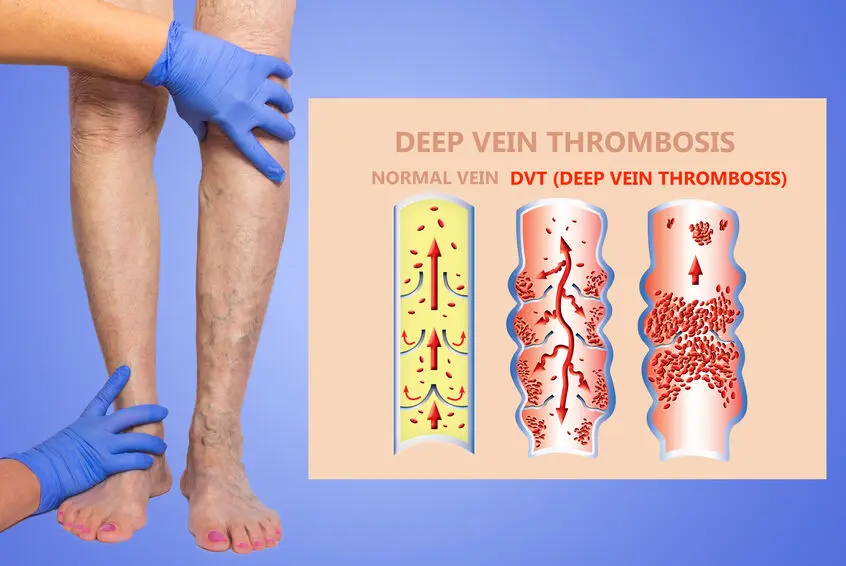
Compression socks are medical-grade or performance garments designed to apply controlled pressure to the legs. This pressure improves blood circulation, reduces fluid buildup, and helps relieve swelling caused by conditions such as edema, lymphedema, pregnancy, or long hours on your feet.
They work through a principle called gradient compression—the socks are tightest at the ankle and gradually loosen as they move up the calf. This encourages veins and arteries to push blood back toward the heart, preventing fluid from pooling in the lower limbs. Without this support, swelling can lead to discomfort, varicose veins, or even complications like deep vein thrombosis (DVT).
Key Benefits of Compression Socks for Swelling
- Improved circulation – Keeps blood moving efficiently from the legs to the heart.
- Reduced swelling and edema relief – Prevents fluid accumulation in feet, ankles, and calves.
- Pain and fatigue reduction – Eases pressure and heaviness caused by poor circulation.
- Preventive care – Lowers the risk of varicose veins, blood clots, and long-term venous issues.
Compression socks aren’t just for medical patients. They’re also popular with athletes, frequent travelers, office workers, and the elderly, making them a versatile solution for a wide range of lifestyles and health needs.
Types of Compression Socks for Swelling
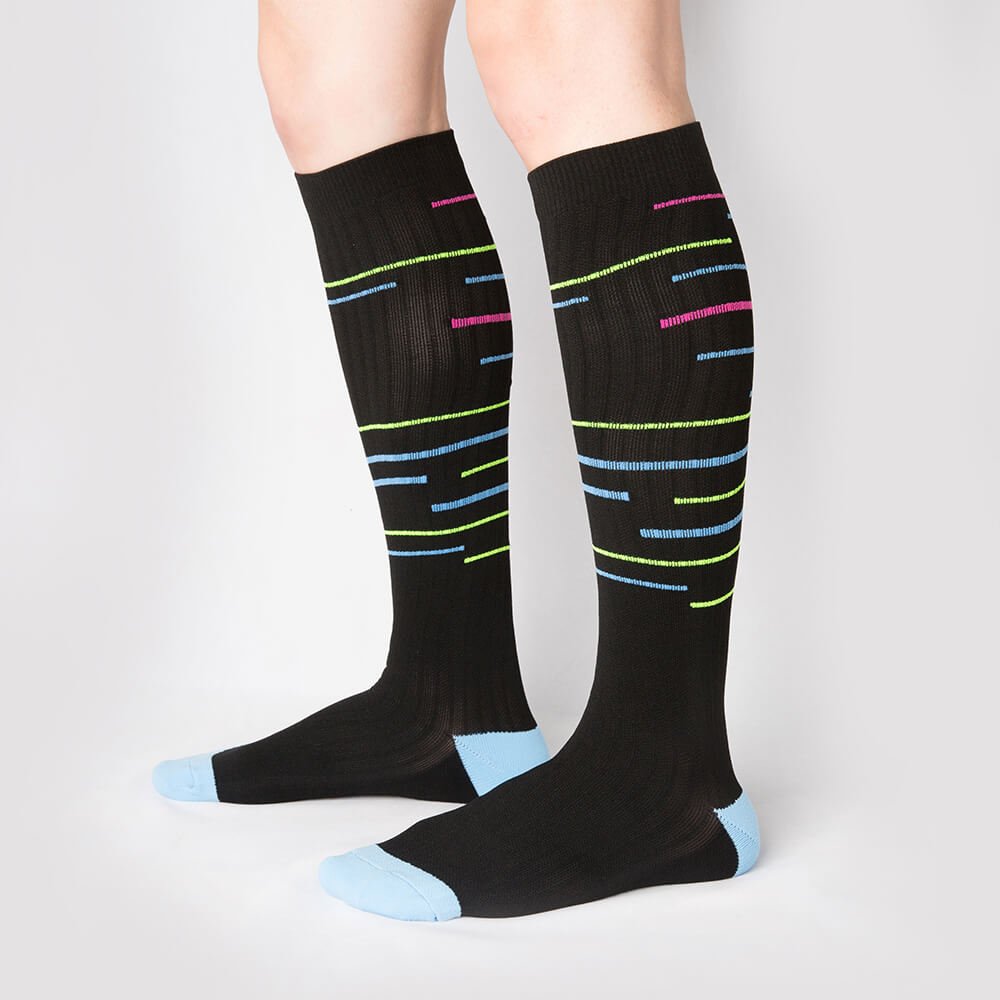

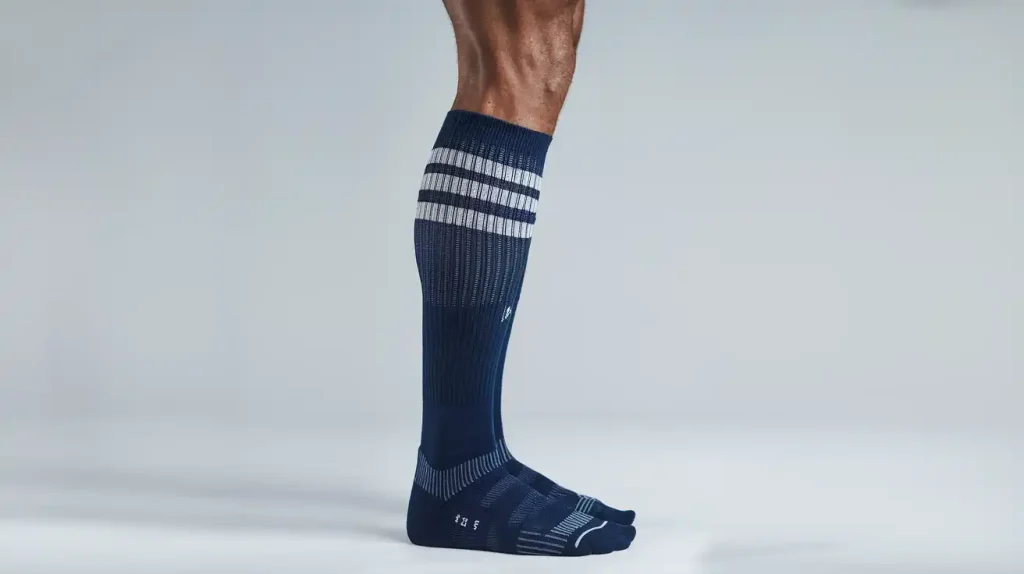
Not all compression socks are the same—and choosing the right type makes a huge difference in how much relief you’ll actually get. The best option depends on your condition, the severity of your swelling, and your daily lifestyle.
Graduated Compression Socks
- How they work: Apply the strongest pressure at the ankle, with a gradual decrease up the calf.
- Best for: Mild to moderate swelling, long days on your feet, or standing jobs.
- Why choose them: Comfortable for everyday use, discreet, and available in many styles.
Medical-Grade Compression Socks
- How they work: Provide higher, more consistent pressure (20–30 mmHg or higher).
- Best for: Severe edema, lymphedema, recovery after surgery, or doctor-prescribed therapy.
- Why choose them: Clinically proven to improve circulation and reduce fluid buildup, but they should be selected under medical guidance.
Athletic Compression Socks
- How they work: Designed with athletes in mind, balancing support with breathability.
- Best for: Runners, travelers, or anyone with an active lifestyle who needs circulation support and faster muscle recovery.
- Why choose them: Reduce swelling, enhance performance, and speed up post-workout recovery.
Zippered or Easy-On Compression Socks
- Why choose them: They provide convenience without sacrificing compression benefits.
- How they work: Include a side zipper or an easier entry design for effortless wear.
- Best for: Seniors, people with limited mobility, or those who struggle to put on tighter socks.
How to Choose the Best Compression Socks for Swelling
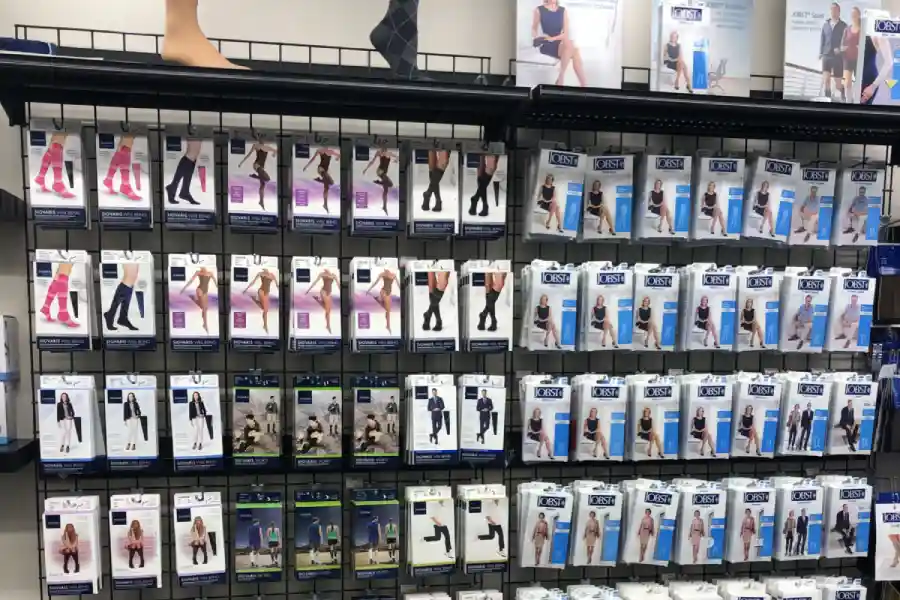
Finding the right compression socks isn’t just about grabbing the first pair you see—the right choice can mean the difference between real relief and wasted money. To get the best results, focus on three key factors: compression level, fit and sizing, and material.
Compression Levels for Swelling Relief (mmHg Explained)
Choosing the right compression level is the most important step when buying compression socks. Compression is measured in mmHg (millimeters of mercury), which indicates the amount of pressure applied to your legs. The right strength depends on your condition and comfort needs.
| Compression Level | Pressure Range | Best For | Notes |
|---|---|---|---|
| Light Compression | 8–15 mmHg | Mild swelling, pregnancy, travel, preventive use | Comfortable for beginners, gentle daily support |
| Medium Compression | 15–20 mmHg | Moderate swelling, long work shifts, early varicose veins, athletic recovery | Most popular choice for all-day wear |
| Firm Compression | 20–30 mmHg | Severe edema, lymphedema, post-surgery recovery | Strong therapeutic pressure; usually recommended by doctors |
| Medical-Grade Compression | 30–40 mmHg+ | Chronic lymphedema, advanced venous disorders | Requires medical supervision; not for casual use |
Fit and Sizing
Compression socks only work if they fit correctly. Too loose, and they won’t provide enough pressure; too tight, and they can restrict circulation.
- Always measure your ankle circumference, calf circumference, and foot length before purchasing.
- Check each brand’s sizing chart, since measurements can vary significantly.
- The ideal fit should feel snug, supportive, and comfortable, not constrictive.
Material & Comfort
The fabric can make a huge difference in breathability, durability, and all-day comfort.
- Nylon/Spandex blends: Durable, stretchy, and moisture-wicking—great for everyday use.
- Cotton blends: Soft and breathable, good for sensitive skin.
- Merino wool or bamboo: Natural odor control, eco-friendly, and ideal for people prone to irritation.
How to Pick the Right Strength
- Start low: If you’re new to compression socks, begin with 8–15 mmHg or 15–20 mmHg and increase only if symptoms persist.
- Match condition to pressure: Light compression helps with mild swelling or pregnancy; firm compression is for medical needs.
- Consult a healthcare provider if you have severe edema, lymphedema, or circulation disorders before choosing 20–30 mmHg or higher.
👉 Pro tip: Always combine compression level with proper fit and material. Even the right mmHg won’t help if your socks are too loose, too tight, or made from uncomfortable fabrics.
How Long to Wear Compression Socks for Swelling Relief (Daily Guide)
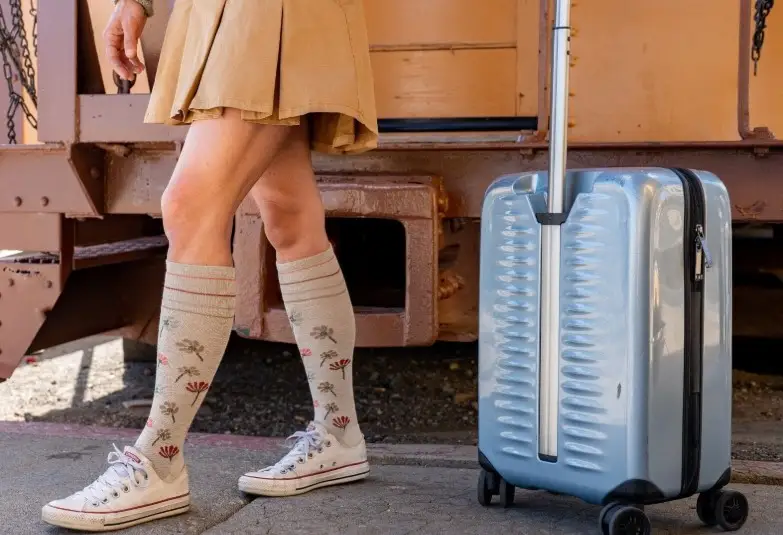
The duration of wearing compression socks depends on the severity of the swelling and the intended purpose.
For general use, most individuals can wear compression socks for the entire day, from morning to evening. If you’re using them during a flight, you can wear them for the duration of the flight. For athletes, wearing them during physical activity or during recovery afterward can help alleviate swelling and improve circulation.
If you have medical conditions, it’s essential to follow your healthcare provider’s recommendations for wearing compression socks. For example, some may advise wearing them for a few hours per day, while others may recommend continuous use, especially if you’re dealing with severe edema or other circulatory problems.
| Duration of Use | Purpose | Recommendation |
|---|---|---|
| Full Day Use | General relief from swelling | 8-10 hours |
| During Travel | Prevent swelling during long flights | Entire flight duration |
| Post-Athletic Activity | Recovery after sports or physical activity | 1-3 hours after activity |
What Are the Benefits of Compression Socks Beyond Swelling Relief?
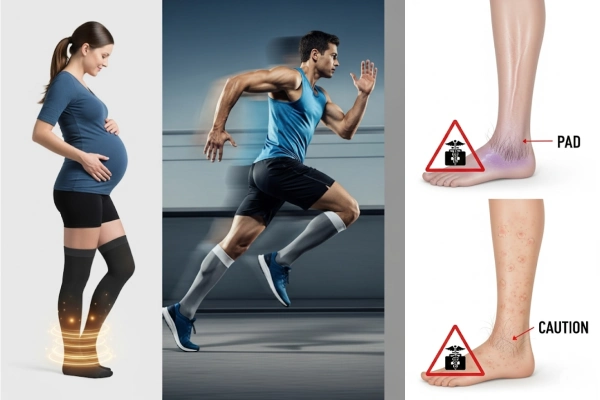
Compression socks aren’t just for people with edema—they deliver a wide range of health and lifestyle benefits. Whether you’re an athlete, frequent traveler, or someone who spends long hours on their feet, these socks can improve comfort, endurance, and overall well-being.
1. Improved Circulation
Compression socks apply graduated pressure that keeps blood moving upward toward the heart. This helps prevent venous insufficiency and lowers the risk of deep vein thrombosis (DVT), making them a staple in hospitals and for frequent flyers.
2. Enhanced Athletic Performance & Recovery
Runners, cyclists, and gym-goers often wear compression socks to limit muscle vibration, reduce fatigue, and speed up recovery. Better circulation means less lactic acid buildup and faster healing after workouts.
3. Reduced Leg Fatigue at Work
Teachers, nurses, retail workers, and office professionals benefit from compression socks during long hours of standing or sitting. By reducing heaviness and fatigue, they keep legs energized throughout the day.
4. Travel & Post-Surgery Support
Compression socks are strongly recommended during long flights or after surgical procedures to prevent blood clots and swelling. They offer a simple, non-invasive safeguard for circulatory health.
👉 For businesses, promoting these broader benefits means reaching not only medical patients but also athletes, travelers, and professionals who want better comfort and performance.
Are There Any Risks or Side Effects?
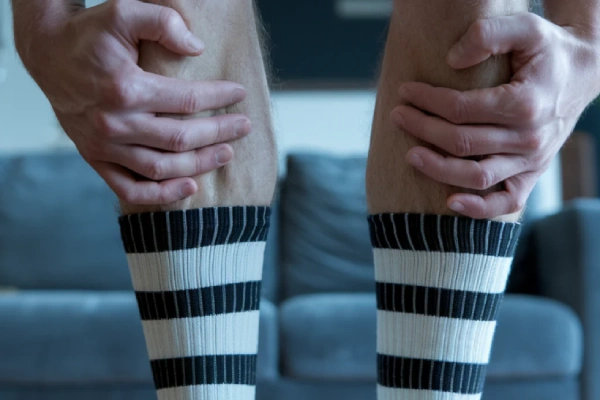
While compression socks are safe for most people, a poor fit or the wrong compression level can cause problems. Here are the main concerns to watch out for:
- Discomfort: Socks that are too tight can dig into the skin or restrict circulation. Always measure ankle and calf size before purchasing.
- Skin Irritation: Sensitive users may experience itching or rashes from synthetic fabrics. Hypoallergenic or cotton-blend options reduce this risk.
- Circulation Issues: People with peripheral arterial disease (PAD) or severe arterial insufficiency should consult a doctor before wearing compression socks.
✔️ The key to avoiding side effects is choosing the right size, fabric, and compression level. With proper fit, compression socks are one of the safest long-term tools for swelling relief, circulation improvement, and fatigue reduction.
How Do Compression Socks Compare to Other Swelling Treatments?
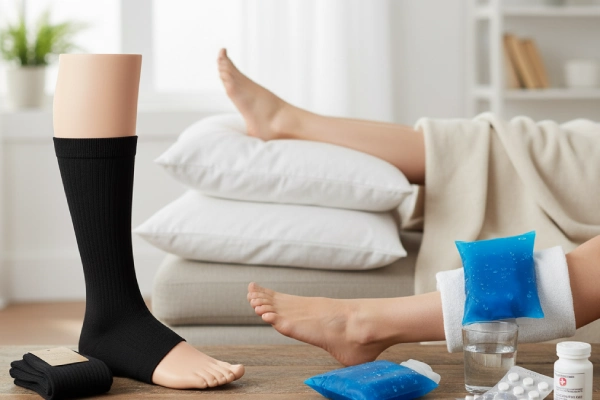
Compression socks are a leading option for treating swelling, but they’re not the only solution. How do they stack up against other treatments, such as medications, elevation, or ice packs?
- Medication: Diuretics are commonly used to help reduce fluid retention, but they often come with side effects like dehydration or electrolyte imbalances. Compression socks, on the other hand, provide a non-invasive, natural solution without these risks. They also offer long-term benefits when used regularly.
- Elevation: Elevating the legs is a simple, natural method to relieve swelling. It works by encouraging fluid to drain back to the upper body. However, this method requires you to stay still for long periods, which is not always practical. Compression socks allow for continued movement and circulation while still offering swelling relief.
- Cold Therapy: Ice packs are often used to reduce swelling in the short term. While effective in the immediate aftermath of injury or excessive swelling, cold therapy doesn’t provide the long-lasting relief that compression socks can offer. Compression socks continue to improve circulation and reduce swelling as you go about your day.
Incorporating compression socks into a broader swelling management plan that includes other treatments can provide the most effective results. Offering a variety of treatment options to customers gives them a well-rounded approach to managing swelling.
Top 10 Best Compression Socks for Swelling (2025 Picks)
| Brand | Best For | Compression Level | Highlights |
|---|---|---|---|
| Jobst Relief | Severe edema, post-surgery | 20–30 mmHg | Doctor-recommended, medical grade |
| Sockwell Lifestyle | Everyday mild swelling | 15–20 mmHg | Merino wool blend, stylish designs |
| CEP Progressive+ | Athletes, recovery | 20–30 mmHg | Sports performance, durable |
| Mediven Comfort | Lymphedema, chronic swelling | 30–40 mmHg | Precision fit, medical-grade |
| 2XU Performance | Travelers, office workers | 15–20 mmHg | Breathable, lightweight |
| Dr. Scholl’s Travel | Flights, occasional swelling | 10–15 mmHg | Widely available, budget friendly |
| Zensah Tech+ | Running & workouts | 15–20 mmHg | Moisture-wicking, athletic cut |
| Fytto 1020 | Fashion + mild edema | 10–15 mmHg | Looks like regular socks, affordable |
| Sigvaris Soft Opaque | Sensitive skin | 15–20 mmHg | Soft fabric, hypoallergenic |
| Copper Fit Energy | Elderly with swelling feet | 15–20 mmHg | Easy on/off, infused with copper |
FAQs About Compression Socks for Swelling
Q1: What are compression socks for swelling?
Compression socks are medical or lifestyle garments designed to apply gentle, graduated pressure to your legs. This pressure helps push blood and lymphatic fluid upward, improving circulation, reducing swelling (edema), and easing leg discomfort. They’re commonly recommended for people with varicose veins, pregnancy-related swelling, or those who sit or stand for long hours.
Q2: How do compression socks work for swelling relief?
They use graduated compression—tighter at the ankle and looser as they move up the calf or thigh. This design prevents blood from pooling in the lower extremities, reduces fluid buildup, and supports the veins in moving blood back toward the heart. The result: less swelling, lighter legs, and reduced risk of complications like blood clots or lymphedema flare-ups.
Q3: How long can I wear compression socks for swelling relief?
Most people benefit from wearing compression socks throughout the day (8–10 hours), especially during long shifts, travel, or recovery periods. Athletes often use them during training or a few hours afterward. For medical conditions, follow your healthcare provider’s guidance.
Q4: Can I wear compression socks while sleeping?
It depends. For mild swelling, they’re usually unnecessary at night. For chronic edema, pregnancy swelling, or if prescribed by a doctor, overnight wear can help reduce morning puffiness. Comfort is key—if socks feel restrictive while sleeping, remove them.
Q5: Can compression socks help with swelling from pregnancy?
Yes. Pregnancy often causes fluid retention and leg swelling due to hormonal changes and increased blood volume. Light to medium compression socks (8–15 mmHg or 15–20 mmHg) can reduce ankle swelling, prevent varicose veins, and improve comfort during daily activities or travel. Always choose gentle compression unless your doctor recommends otherwise.
Q6: What compression level should I choose for swelling?
- 30–40 mmHg+: Medical-grade for chronic conditions like lymphedema—always use under medical supervision.
- 8–15 mmHg: Light support for mild swelling, pregnancy, or travel.
- 15–20 mmHg: Moderate support, ideal for office workers, athletes, or early varicose veins.
- 20–30 mmHg: Firm support for significant swelling, edema, or post-surgery recovery (often doctor-prescribed).
Conclusion
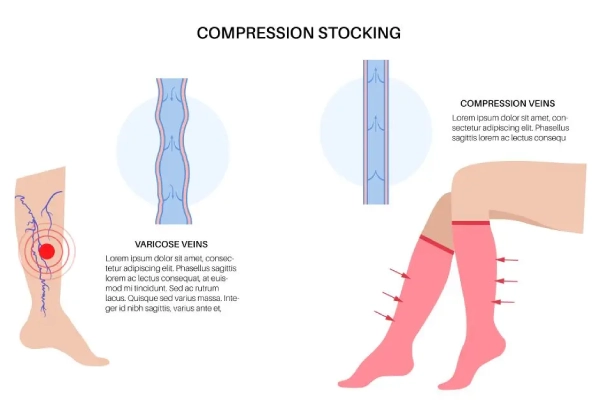
Compression socks provide one of the most effective, non-invasive ways to manage swelling, improve circulation, and reduce fatigue—whether for athletes, travelers, pregnant women, or patients with edema. Choosing the right compression level and material ensures both comfort and long-term relief, while trusted brands guarantee consistent quality.
If your business needs bulk orders, private labeling, or customized compression sock solutions, simply fill in the form on the right (or below) to request free samples and a tailored supply plan from our team.
